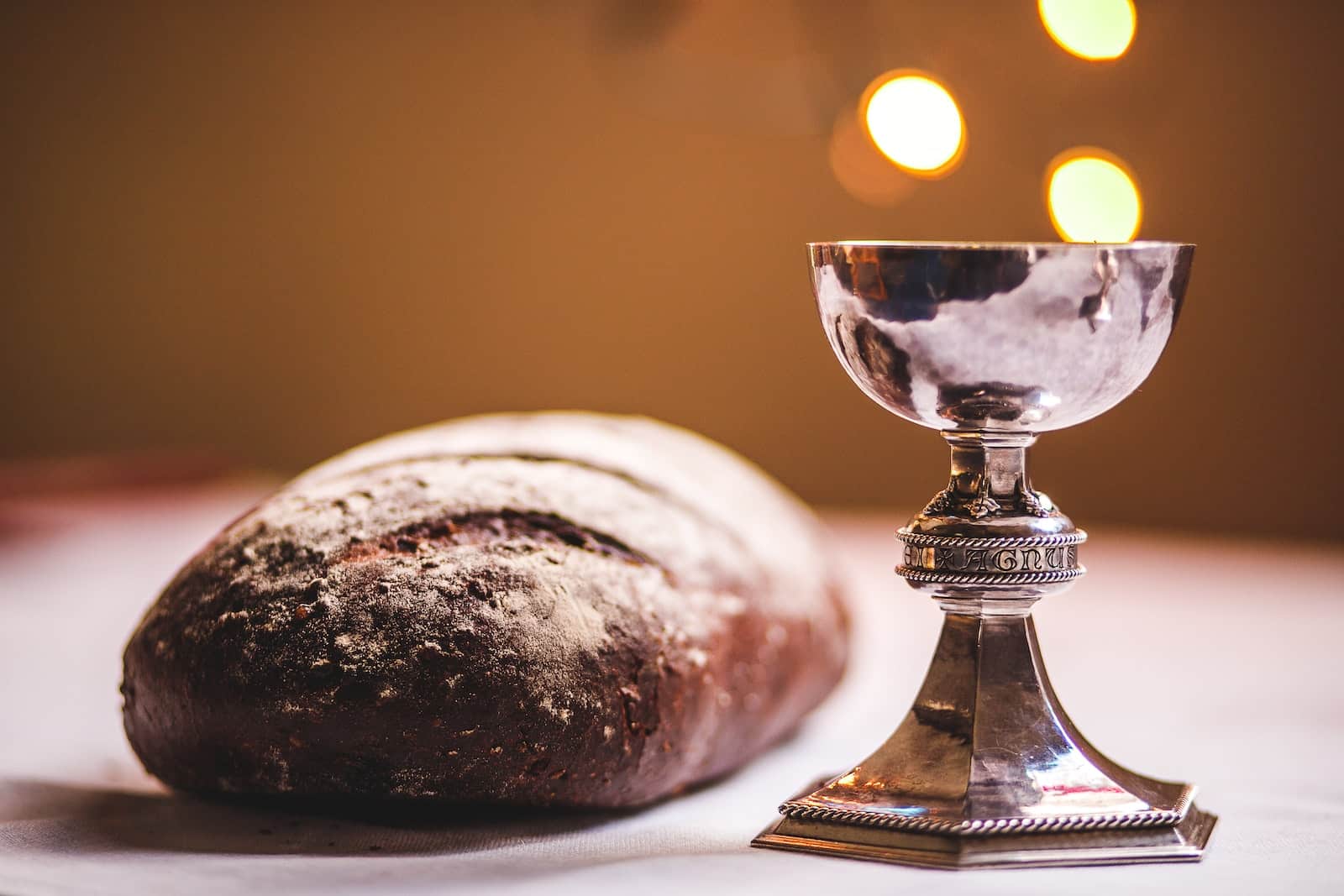One of the most significant errors that developed in the late Middle Ages was the belief that the bread and wine in the eucharist were literally the body and blood of Christ.
Very early on in the development of Christian dogma, participation in the Lord’s Table in particular became significant. It is easy to understand why, since this is what made Christians unique from Jews worshiping in the synagogue. For example, Ignatius of Antioch called the Table the “medicine of immortality.”1Ignatius, The Epistle of Ignatius to the Ephesians, in Roberts, Donaldson, and Coxe, The Apostolic Fathers with Justin Martyr and Irenaeus, 1:58. It was understandable that they placed such an emphasis on the Table, but they also struggled with a particular statement Christ made during his words of institution. Jesus had said, “This bread is my body,” and “This cup is my blood.” Of course, the Protestant Reformers would debate this later, but early on, most Christians leaders took the statement very literally. Ignatius claimed that the Eucharist “is the flesh of Jesus Christ.”2Ignatius, The Epistle to the Romans, in Roberts, Donaldson, and Coxe, The Apostolic Fathers with Justin Martyr and Irenaeus, 1:77 Irenaeus, a pastor in the late second century said, “The bread, when it receives the invocation of God, is no longer common bread, but the Eucharist consisting of two realities, the earthly and the heavenly.”3Irenaeus, Against Heresies, in Roberts, Donaldson, and Coxe, The Apostolic Fathers with Justin Martyr and Irenaeus, 1:486 Likewise, Origin, a third century pastor, claimed, “And this bread becomes by prayer a sacred body, which sanctifies those who sincerely partake of it.”4Origin, Against Celsus, in Alexander Roberts, James Donaldson, and A. Cleveland Coxe, eds., Fathers of the Third Century, vol. 4, The Ante-Nicene Fathers (Buffalo, NY: Christian Literature Company, … Continue reading
What those earliest Christians meant is a matter of considerable debate. However, a clearer mystical belief concerning the eucharist developed in various places during the Middle Ages, first described as “transubstantiation” in the tenth century. The 1215 Fourth Lateran Council dogmatized this doctrine: “The body and blood of Christ are truly contained in the sacrament of the altar under the forms of bread and wine, the bread being transubstantiated into the body and the wine into the blood by divine power.”5Philip Schaff, History of the Christian Church (New York: Charles Scribner’s Sons, 1910), 5:714.
A short time later, Thomas Aquinas (1225–1274) devised the philosophical rationale for transubstantiation.6Thomas Aquinas, Summa Theologica, Part III (c. 1271), trans. Fathers of the English Dominican Province (New York: Benziger Brothers, 1947), II, 2447–2451. Aquinas attempted to synthesize Aristotelian philosophy with Christian theology, and this is perhaps no more evident than in his theology of the eucharist. His doctrine sought to explain how the bread and wine could literally be the body and blood of Christ while still looking and tasting like bread and wine.
Aquinas used Aristotle’s categories of “substance” and “accident” to provide a solution. “Substance” was the very essence of a thing, while “accidents” were a thing’s outward, tangible characteristics. Aquinas argued that when the priest uttered the words, “hoc es corpus meum” (“this is my body”), the substance of the bread transformed into the body of Christ, while its accidents remained unchanged. The same happened with the wine. From the moment of consecration onward, the wafer and wine, separately or together, are “the Lamb of God” to be adored and received for eternal life.
Partaking of the Eucharist results in: (1) forgiveness from venial sins; (2) strengthening against temptation (extinguishing the power of evil desire); and (3) promise of eternal glory and a glorious resurrection. Vatican II (1962–1965) later encouraged frequent or daily participation since it “increases our union with Christ, nourishes the spiritual life more abundantly, strengthens the soul in virtue, and gives the communicant a stronger pledge of eternal happiness.”7Robert Joseph Fox, The Catholic Faith (Huntington, IN: Our Sunday Visitor, 1983), 212–213.
Each of the Protestant Reformers responded to these theological errors.
Luther’s Eucharistic Reforms
In one of Martin Luther’s most significant early works, A Prelude Concerning the Babylonian Captivity of the Church (1520), he argued against what he considered three “captivities” concerning the Lord’s Supper: withholding the cup from the laity, the doctrine of transubstantiation, and understanding the mass as a sacrifice. As to the first “captivity,” Luther argued for the universality of the cup by noting Christ’s statement in the words of institution, “Drink of it, all of you” (Matt. 26:27). Medieval theologians had interpreted the “all” as referring to the cup, but Luther demonstrated that grammatically, “all” referred to “you” in Christ’s command, and thus insisted that all believers should partake. He argued, “But they are the sinners, who forbid the giving of both [bread and cup] to those who wish to exercise this choice. The fault lies not with the laity, but with the priests. The sacrament does not belong to the priests but to all men.”8Martin Luther, The Babylonian Captivity of the Church, 1520, in Luther’s Works (Philadelphia: Fortress Press, 1999), 36:27.
As to the second, Luther argued against the philosophical explanation of the presence of Christ in the eucharist from Aristotle through the writings of Aquinas. He complained, “What shall we say when Aristotle and the doctrines of men are made to be the arbiters of such lofty and divine matters?”9Pelikan, Oswald, and Lehmann, Luther’s Works, 36:33. He insisted that Christ is really present in the bread and wine itself, but the substance of the elements does not change. Instead, he presented what he called “sacramental union”—the idea that Christ is present spiritually:
Therefore, it is entirely correct to say, if one points to the bread, “This is Christ’s body,” and whoever sees the bread sees Christ’s body, as John says that he saw the Holy Spirit when he saw the dove, as we have heard. Thus also it is correct to say, “He who takes hold of this bread, takes hold of Christ’s body; and he who eats this bread, eats Christ’s body; he who crushes this bread with teeth or tongue, crushes with teeth or tongue the body of Christ.” And yet it remains absolutely true that no one sees or grasps or eats or chews Christ’s body in the way he visibly sees and chews any other flesh. What one does to the bread is rightly and properly attributed to the body of Christ by virtue of the sacramental union.10Martin Luther, Confession Concerning Christ’s Supper, 1528, in Pelikan, Oswald, and Lehmann, Luther’s Works, 37:300.
Yet, he insisted, “even though philosophy cannot grasp this, faith grasps it nonetheless. And the authority of God’s Word is greater than the capacity of our intellect to grasp it.”11Luther, Babylonian Captivity, Pelikan, Oswald, and Lehmann, Luther’s Works, 36:35.
Zwingli’s Eucharistic Reforms
Like Luther, Swiss Reformer Ulrich Zwingli held the Eucharist to be important, but he believed that it had been grossly perverted, particularly with the doctrine of transubstantiation. Yet, while Luther and Zwingli agreed in their repudiation of transubstantiation, they could not come to a consensus on the meaning of “this is my body,” the only one of fifteen articles in the Marburg Articles (an attempt at Lutheran and Zwinglian unification) the Zwinglians could not sign.12Details of the Marburg Colloquy between Luther and Zwingli are described in Luther’s Works, 38:15-39. Luther argued that Christ could be literally present in sacramental union with the elements, while Zwingli insisted that Christ was present only at the Father’s right hand and that the elements of the Lord’s Supper were a memorial only; Christ’s words were not to be taken literally:
For it is clear that if they insist upon a literal interpretation of the word “is” in the saying of Christ: “This is my body,” they must inevitably maintain that Christ is literally there, and therefore they must also maintain that he is broken, and pressed with the teeth. Even if all the senses dispute it, that is what they must inevitably maintain if the word “is” is taken literally, as we have already shown. Hence, they themselves recognize that the word “is” is not to be taken literally.13Ulrich Zwingli, On the Lord’s Supper, 1526, in Bromiley, Zwingli and Bullinger, 195.
Because he was concerned about the abuses, Zwingli’s Communion services took place sitting around tables and occurred only once a quarter—on Christmas, Easter, Pentecost, and the patronal festival of Zurich (September 11)—rather than weekly. He stressed that the nature of the meal was thanksgiving: “This memorial is a thanksgiving and a rejoicing before Almighty God for the benefit which he has manifested to us through his Son.”14Ulrich Zwingli, “The Lord’s Supper as administered in Zurich, 13 Apr. 1525,” in Beresford James Kidd, Documents Illustrative of the Continental Reformation (Charleston, SC: BiblioBazaar, 2009), … Continue reading
Martin Bucer’s Eucharistic Reforms
German Reformer Martin Bucer replaced the sanctuary altar with a table in order to return the symbolism to a meal rather than a sacrifice, arguing, “we have only one altar, one sacrifice, and one priest—all of these are Christ.”15Cypris, Martin Bucer’s Ground and Reason, 133. He intentionally used the term “Lord’s Supper” instead of “mass”16Cypris, Martin Bucer’s Ground and Reason, 87. and sought to bring the reading and preaching of the Word (lectio continuo) back to a place of significance alongside the Table. He rejected what he considered ceremonies of human origin, including vestments, insisting that church leaders had no right to invent new forms or to “enrich” existing forms with such innovations which either hid or replaced the basically biblical signs in worship. He noted,
The Lord instituted nothing physical in his supper except the eating and drinking alone, and that for the sake of the spiritual, namely as in memory of him. … [Yet] we have observed that many cared neither to consider seriously the physical reception nor the spiritual memorial, but instead, just as before, were satisfied with seeing and material adoration.17Cypris, Martin Bucer’s Ground and Reason, 117–18.
John Calvin’s Eucharistic Reforms
Genevan Reformer John Calvin desired that Communion be observed “at least once a week,”18Calvin, Institutes, 4.17.43. but the ruling council of Geneva would not allow it, instead following Zwingli’s example of quarterly celebration. When observing the Table, his service transitioned between the Service of the Word and Communion with the traditional practice of affirming the Apostles’ Creed, although for Calvin this consisted of a sung version. The service contained a prayer of thanks, including an invocation and the Lord’s Prayer. Interestingly, here Calvin preserved the traditional Sursum Corda, yet as a prose monologue:
Let us raise our hearts and minds on high, where Jesus Christ is, in the glory of his Father, and from whence we look for him at our redemption.19John Calvin, The Form of Church Prayers, 1542, in Prayers of the Eucharist, 287.
In Calvin’s eucharistic theology, he recovered the New Testament idea that in Christ and by the Holy Spirit, worshipers are raised to join in with the worship of heaven, represented at this climactic moment in the service:
Let us not be bemused by these earthly and corruptible elements which we see with the eye, and touch with the hand, in order to seek him there, as if he were enclosed in the bread or wine. Our souls will only then be disposed to be nourished and vivified by his substance, when they are thus raised above all earthly things, and carried as high as heaven, to enter the kingdom of God where he dwells. Let us therefore be content to have the bread and the wine as signs and evidences, spiritually seeking the reality where the word of God promises that we shall find it.20Prayers of the Eucharist, 287.
After reading the Words of Institution from 1 Corinthians 11, which unlike Luther and Bucer preceded the eucharistic prayer, the people partook of Communion, during which they sang a psalm of thanksgiving (Psalm 138). When all had finished, another prayer of thanksgiving was offered, and the service concluded with a final psalm of praise.
Calvin’s worship reforms in Geneva became the influential standard and model for several other traditions and have come to characterize quintessential Reformed worship. Calvin achieved unity with Zwingli’s successor, Heinrich Bullinger (1504–1575), and subsequently the rest of the Swiss Reformed, in the Consensus Tigurinus of 1549, further defining the Reformed tradition.
This is excepted from Changed from Glory into Glory: The Liturgical Story of the Christian Faith by Scott Aniol.
References
| 1 | Ignatius, The Epistle of Ignatius to the Ephesians, in Roberts, Donaldson, and Coxe, The Apostolic Fathers with Justin Martyr and Irenaeus, 1:58. |
|---|---|
| 2 | Ignatius, The Epistle to the Romans, in Roberts, Donaldson, and Coxe, The Apostolic Fathers with Justin Martyr and Irenaeus, 1:77 |
| 3 | Irenaeus, Against Heresies, in Roberts, Donaldson, and Coxe, The Apostolic Fathers with Justin Martyr and Irenaeus, 1:486 |
| 4 | Origin, Against Celsus, in Alexander Roberts, James Donaldson, and A. Cleveland Coxe, eds., Fathers of the Third Century, vol. 4, The Ante-Nicene Fathers (Buffalo, NY: Christian Literature Company, 1885), 652. |
| 5 | Philip Schaff, History of the Christian Church (New York: Charles Scribner’s Sons, 1910), 5:714. |
| 6 | Thomas Aquinas, Summa Theologica, Part III (c. 1271), trans. Fathers of the English Dominican Province (New York: Benziger Brothers, 1947), II, 2447–2451. |
| 7 | Robert Joseph Fox, The Catholic Faith (Huntington, IN: Our Sunday Visitor, 1983), 212–213. |
| 8 | Martin Luther, The Babylonian Captivity of the Church, 1520, in Luther’s Works (Philadelphia: Fortress Press, 1999), 36:27. |
| 9 | Pelikan, Oswald, and Lehmann, Luther’s Works, 36:33. |
| 10 | Martin Luther, Confession Concerning Christ’s Supper, 1528, in Pelikan, Oswald, and Lehmann, Luther’s Works, 37:300. |
| 11 | Luther, Babylonian Captivity, Pelikan, Oswald, and Lehmann, Luther’s Works, 36:35. |
| 12 | Details of the Marburg Colloquy between Luther and Zwingli are described in Luther’s Works, 38:15-39. |
| 13 | Ulrich Zwingli, On the Lord’s Supper, 1526, in Bromiley, Zwingli and Bullinger, 195. |
| 14 | Ulrich Zwingli, “The Lord’s Supper as administered in Zurich, 13 Apr. 1525,” in Beresford James Kidd, Documents Illustrative of the Continental Reformation (Charleston, SC: BiblioBazaar, 2009), 444. |
| 15 | Cypris, Martin Bucer’s Ground and Reason, 133. |
| 16 | Cypris, Martin Bucer’s Ground and Reason, 87. |
| 17 | Cypris, Martin Bucer’s Ground and Reason, 117–18. |
| 18 | Calvin, Institutes, 4.17.43. |
| 19 | John Calvin, The Form of Church Prayers, 1542, in Prayers of the Eucharist, 287. |
| 20 | Prayers of the Eucharist, 287. |




